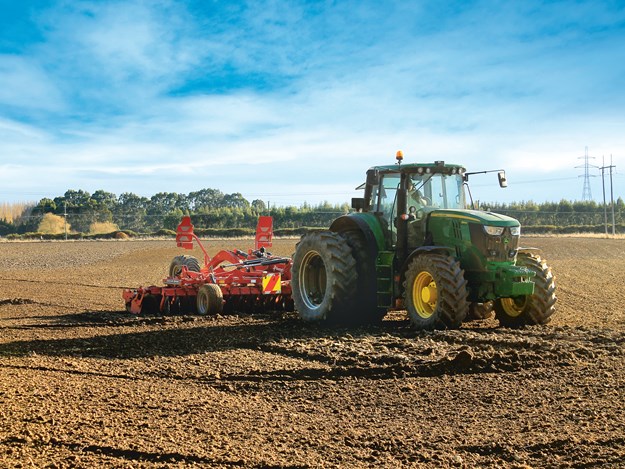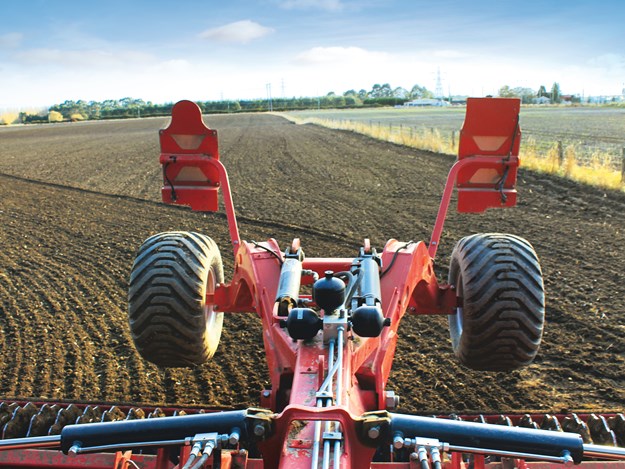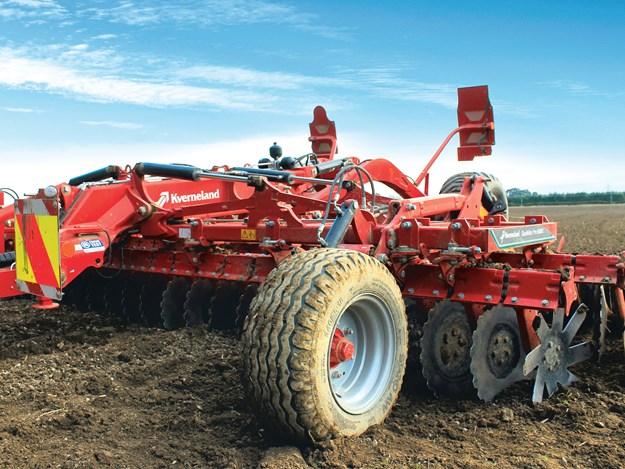Review: Kverneland Qualidisc Pro 6000T
Farm Trader takes a closer look at the Kverneland Qualidisc Pro 6000T in action
.jpg)
Quality soil preparation is the literal foundation for growing good-quality crops but finding the right machine for the job is no easy task. Especially when you’re attempting to grow black oats in Winton, Southland soils. The Kverneland Qualidisc Pro 6000T proves to be up to the task so we set out to take a closer look at this machine in action.

The agricultural sector covers a wide variety of speciality areas throughout the New Zealand landscapes: wine in Marlborough and Hawke’s Bay, dairy farming in the Waikato, and merino sheep in the southland High Country to name just a few.
On a recent trip to the deep south, I caught up with the Saunders family, Owen and son Brendan, who farm in the small rural service town of Winton. With 150 hectares of flat prime southland land, they have more than a few ewes and about 100 hectares planted in oats, which is pretty common down that way as a green feed crop for stock.
However, Owen and Brendan are growing black oats, a variety that particularly suits the climate there. This makes fantastic horse feed when cut for chaff and is stored to cut as required and sold as Sam Chaff in 35kg bags – loaded onto pallets and trucked out to be distributed throughout the country.
A recent addition to the machinery side of their business is the Kverneland Qualidisc Pro 6000T. Before jumping in the ute and heading down to their local dealership to grab the first set of speed discs they could get their hands on, they headed to a demo day at the Waimumu Field Days site. Here they saw and compared a number of different brands and saw how the machines performed in the conditions available for demonstration.
 |
|
Forward speed of 16km/hr at low rpm great for fuel economy
|
The six-metre Kverneland Qualidisc came out on the top for their requirements. Having put it up against two other brands of speed discs since purchasing their Kverneland Qualidisc, it triumphed both times, leaving the other machines in its dust or clogged up with soil and unable to handle the conditions when the going got tough.
Although not the cheapest option available on the market, it’s been a well-thought-out investment, as the machine is able to handle whatever has been thrown at it and does a great job along the way, making their life easy.
Owen has a good relationship with his local Power Farming dealership in Invercargill, who have supplied him with Merlo telehandlers for his business over the years and also proved helpful in getting the Kverneland discs set up the best way to suit Owen and Brendan’s requirements.
An example of this is being advised to fit the star disc to the front left gang to prevent soil from the front gang from being thrown too far and leaving lumps.
Test time
Although in the past, oats for harvest have been spring sown, Owen has found that getting them planted in autumn has produced a more consistent yield and allows them to get through the busy harvest when the weather is more favourable.
In early May, when I caught up with Owen and Brendan, they were getting one of their last paddocks cultivated, ready to be planted. Although on this occasion Brendan had ploughed the harvested oaten stubble, the new six-metre Qualidiscs have the ability to work stubble ground in preparation for planting.
 |
|
Star disc outer front left to keep dirt from being thrown too far
|
Easy tool-free depth adjustment, with slide-in plates on the hydraulic rams, allow working depth adjustment between three and 15cm on the Pro model. The Saunders have found they could work straight stubble ground with the Qualidisc up to three times before planting and still be more efficient than they were previously.
Prior to the Qualidisc joining the team, paddocks would all be ploughed, followed by a three-metre power harrow and planting, as is often standard practice. As well as the obvious benefits of running a wider machine like the six-metre Qualidisc, the forward speed is greater. Forward speed of 16km/hour is quite achievable and helps the discs work at their optimum for cutting into the soil and mixing any crop residues. The six-metre version is supposed to require 190 to 350hp to pull. On flat ground, the Saunders John Deere 6195 was not working hard on the job, keeping revs lows, burning around 12 to 14 litres of diesel per hour, significantly less than the power harrow.
Operation
This is all pretty straightforward in terms of operation, and with the disc angles already set by the legs, there’s no issue with set-up if somebody different operates for the day. The main adjustment is around the height, which is governed by the rear roller on the Pro version. Adjusted hydraulically, with slide in depth plates, no tools required, keeping life simple and easy. Trailed versions also have the option of front-mounted wheels to control depth of cut, with the same adjustment system.
 |
|
Finish in the background, ready for a quick level and planting
|
A total of three to four double-acting hydraulic remotes are required to operate the trailed version, depending on specifications. Hydraulic folding for transport brings the six-metre width down to 2.75 metres, with front and rear lighting and overwidth panels as standard. Two-point linkage and Cat III/IV mounting provide good manoeuvrability in the paddock. The rear transport wheels are used just for transport, using the linkage to lift the discs out of the ground, running on the rear roller.
Design
A key component of a disc cultivator of any sort, and an area that Kverneland has put plenty of thought into, is the design of the discs to achieve the desired result – a smooth, worked-up paddock with a long life span and low overall running costs of the machine.
The special heat-treating process gives one of the hardest discs available on the Kverneland Qualidisc and certainly helps provide good wear characteristics. A softer steel centre is designed to provide flex in harsh stony conditions, rather than cracking.
 |
|
Knives on the back of the acti-pack roller slice any remaining clods
|
Some Kverneland Qualidiscs operating in stony Canterbury soils are still operating on their original discs, even after 6000-plus hectares.
Another notable feature of the Pro version is the adjustment of the angle of the discs as they wear: based on diameter to ensure the soil is worked evenly, not leaving ridges, which also helps make sure you get maximum wear out of each disc before needing to replace it.
Owen’s machine after a couple of seasons operating in the Southland soils is still like new. Conical notched discs cut through the soil, with the ability to carry more soil vs a flat disc and at the same time provide a greater mixing effect.
Modern speed discs use a rubber torsion mounting system for each individual disc leg. Each disc is connected to the legs by a maintenance-free, sealed, double-race bearing. An O-ring on the disc side and five sealing lips on the other side help prevent soil and moisture from getting into the bearing, which could otherwise cause it to fail. Another factor to consider here is the overall weight of the machine, which has been carefully designed to get the discs to bite into the hardest and driest soil conditions. The six-metre trailed version, fitted with the heavy Actipack roller, tips the scales at 5662kg with strong eight and 10mm box section steel used in the construction of the frame.
 |
|
Transport wheels raised in work, using linkage to lift discs out of the ground
|
Rollers
A number of roller choices are available to fit the rear of the Kverneland Qualidisc range of machines. Mounted machines have fewer options due to weight. However, I was impressed with the Actipack roller fitted on this test machine. Its independent knives and skids, working in conjunction with the breaker rings of the roller, do a great job of breaking up the clods. It’s designed to work in medium to heavy soils and also handle wetter conditions (similar to what we experienced on our test day) without blocking up or adversely affecting the quality of the job and optimal seedbed preparation. There are four elements to the Qualidisc: the two rows of cutting discs 900mm apart and the rear roller. Between the second row of discs and mounted from the roller is a row of manually adjustable spring tines, which pre-level and firm the soil before the roller does its job.
 |
|
Some of the near 100 ex-semi-trailers used to cart oats in after harvest to storage
|
Summary
No one ever regrets buying quality, and that’s what you get with Kverneland Qualidisc. Although there are plenty of options to choose from in terms of speed discs available in New Zealand, of those that I have seen in action, the Qualidisc would definitely be up there in terms of build quality and job finish. A lot of things may be done using traditional methods in the production of Sam Chaff but with the addition of the Kverneland machine to their fleet, Owen and Brendon are up to date with modern cultivation methods. In turn, this ensures they can get the best crop of oats year after year, as cost-effectively and efficiently as possible.
 |
|
Front wheels ensure even operating depth and avoid machine hoping
|
Kverneland Qualidisc Pro 6000T Specifications
| Working width | 6m |
| Transport width | 2.75m |
| Number of discs | 48 |
| Disc diameter | 600x6mm |
| Disc spacing | 250mm |
| Interrow distance | 900mm |
| Working depth | 3-15cm |
| Depth adjustment | Hydraulic by spacer |
| Hydraulic valves required | 4 or 3 double acting |
| Weight | 5662Kg |
| Roller | 560mm Actipack |
| Mounting | 2-point linkage cat III/IV |
| Tyres | 400/60x15.5, 480/45x17, 520/50x17 |
| Gauge wheels | 2 x 340/55x16 |
| Brakes | Hydraulic or pneumatic |
| Hp required | 190-350hp |
| Importer/distributor | Power Farming |
Pros
- Superior finish, ready for planting
- Efficient operation, high forward speed with low fuel usage
- Easy, tool-free adjustment
- Disc adjustment to get full wear out of discs before replacement
- Correct set-up allows work to go ahead in difficult soil conditions
Cons
- Higher initial cost, but well worth the extra expense
- Hydraulic bans required – 3–4; most tractors operating these should have enough
Find new and used farm machinery for sale in NZ
Keep up to date in the industry by signing up to Farm Trader's free newsletter or liking us on Facebook










.jpg)

.jpg)
.jpg)
.jpg)

